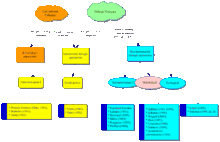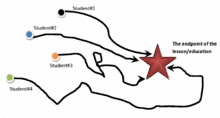Dialogic pedagogy
Dialogic pedagogy is a theory and practice of teaching in which dialogue is central. Teachers and students are in an equitable relationship and listen to multiple points of view.
History
Although modern interest in dialogic pedagogy seems to emerge only in the 1960s, it was a very old and probably widespread educational practice. Perhaps one of the best known examples of dialogic pedagogy in the Ancient times is the Socratic method described by his student Plato.[1] However, dialogic practices and dialogic pedagogy existed in Ancient Greece, before, during, and after Socrates' time, possibly in other forms than those depicted by Plato.[2] There has been a long tradition of dialogic pedagogy, called Chavruta/Chavrusa/Havruta, in Jewish Yeshivas, involving dialogic studies of Talmudic texts, that goes back to the eras of the Tannaim (Rabbis of the Mishnaic period, 10-220 CE).[3] Economist Amartya Sen argues that dialogic pedagogy has been well situated within the Indian religious and civic traditions and spread across Asia with the rise of Buddhism.[4]
In more recent times, Mikhail Bakhtin introduced the idea of dialogism, as opposed to "monologism", to literature.[5] Paulo Freire's work, Pedagogy of the Oppressed introduced these ideas to educational theory.[6]
Formats
There are a number of formats of instruction, that have been recognized as "dialogic" (as opposed to "monologic").
- Interactional: Dialogue involves a high student-teacher talk ratio, short utterances/turns, and interactive exchanges.[7]
- Question-answer: Dialogue involves either a teacher asking students questions and eliciting answers from the students or students asking questions and eliciting answers from the teacher and/or one another.[8]
- Conversational: Instructional dialogue is modeled after natural mundane everyday conversations.[9]
- Without authority: Dialogic guidance occurs among equal peers as authority distorts dialogic processes. Jean Piaget[10] was the first scholar who articulated this position.
Types
There are a number of types of dialogic pedagogy, that is, where the form and the content is recognized as "dialogic".
- Paideia: Learning through asking thought-provoking questions, challenging assumptions, beliefs, and ideas, that involves argumentation and disagreements.[11] This notion comes from Socratic dialogues described and developed by Plato.[1]
- Exploratory talk for learning: Collective mindstorming and probing ideas, enabling "the speaker to try out ideas, to hear how they sound, to see what others make of them, to arrange information and ideas into different patterns" (p. 4).[12]
- Internally persuasive discourse: Bakhtin's[13] notion of "internally persuasive discourse" (IPD) has become influential in helping conceptualize learning. There are at least three approaches to how this notion is currently used in the literature on education:
- IPD is understood as appropriation when somebody else's words, ideas, approaches, knowledge, feelings, become one's own. In this approach, "internal" in IPD is understood as an individual's psychological and personal deep conviction.[14][15]
- IPD understood as a student's authorship recognized and accepted by a community of practice, in which the student generates self-assignments and long-term projects within the practice.
- IPD is understood as a dialogic regime of the participants' testing ideas and searching for the boundaries of personally-vested truths. In this approach, "internal" is interpreted as internal to the dialogue itself in which everything is "dialogically tested and forever testable" (p. 319).[16]

Instrumental

Instrumental dialogic pedagogy uses dialogue for achieving non-dialogic purposes, usually making students arrive at certain preset learning outcomes. For example, Nicolas Burbules defines dialogue in teaching instrumentally as facilitating new understanding, "Dialogue is an activity directed toward discovery and new understanding, which stands to improve the knowledge, insight, or sensitivity of its participants".[17]
The teacher presets the endpoint of the lesson, for example, "At the end of the lesson, the students will be able to understand/master the following knowledge and skills." However, the teacher's method of leading students to the endpoint can be individualised both in instruction techniques and in time taken. Different students are "closer" or further" from the endpoint and require different strategies to get them there. Thus, for Socrates to manipulate Meno to the preset endpoint - what is virtue is not known and problematic - is not the same to manipulate Anytus to the same endpoint. It takes different and individualized instructional strategies.[18]
Socrates,[1] Paulo Freire[19][20] and Vivian Paley[21] all strongly critique the idea of preset endpoints however in practice they often set endpoints.[18]
Instrumental dialogic pedagogy remains influential and important for scholars and practitioners of dialogic pedagogy field.[22] Some appreciate its focus on asking good questions, attendance to subjectivity, use of provocations and contradictions, and the way it disrupts familiar and unreflected relations. However, others are concerned about the teacher's manipulation of the student's consciousness and its intellectualism.
Non-instrumental
In contrast to instrumental approaches to dialogic pedagogy, non-instrumental approaches to dialogic pedagogy view dialogue not as a pathway or strategy for achieving meaning or knowledge but as the medium in which they live.[18][23][24] Following Bakhtin, meaning is understood as living in the relationship between a genuine question seeking for information and a sincere answer aiming at addressing this question.[25] Non-instrumental dialogic pedagogy focuses on "eternal damn final questions". It is interested in the mundane only because it can give it the material and opportunity to move to the sublime. This is seen, for example, in the work of Christopher Phillips.[22]
The non-instrumental "epistemological dialogue", a term introduced by Alexander Sidorkin,[24] is a purified dialogue to abstract a single main theme, a development of a main concept, and unfold the logic. According to Sidorkin,[24] ontological dialogic pedagogy priorities human ontology in pedagogical dialogue:
Sociolinguist Per Linell[26] and educational philosopher Alexander Sidorkin[24] evidence a non-instrumental ecological approach to dialogic pedagogy that focuses on the dialogicity[5][18] of the mundane everyday social interaction, its non-constrained nature, in which participants can have freedom to move in and out of the interaction, and the absence or minimum of pedagogical violence. Using the metaphor of "free-range kids", Lenore Skenazy[27] defines the participants in this ecological dialogue as free-range dialogic participants.
See also
- Dialogic
- Dialogic education
- Dialectic process vs. dialogic process
- Dialogical analysis
- Dialogic learning
- Dialogical self
- Relational dialectics
- Intertextuality
- Heteroglossia
Journal publications
References
- Plato (1997). Complete works. Indianapolis, IN: Hackett Pub.
- Apatow, Robert (1998). The spiritual art of dialogue: Mastering communication for personal growth, relationships, and the workplace. Rochester, VT: Inner Traditions.
- Hezser, Catherine (1997). The social structure of the rabbinic movement in Roman Palestine. Tübingen: Mohr Siebeck. ISBN 978-3161467974. OCLC 723016390.
- Sen, Amartya (2005). The argumentative Indian: Writings on Indian history, culture and identity. New York: Farrar, Straus & Giroux. ISBN 9780374105839. OCLC 936760401.
- Bakhtin, Mikhail M. (1999). Problems of Dostoevsky's poetics. Minneapolis: Univ. of Minnesota Press. ISBN 978-0816612284. OCLC 682085417.
- Skidmore, David; Murakami, Kyoko (2016). Dialogic Pedagogy: The Importance of Dialogue in Teaching and Learning. Multilingual Matters. ISBN 9781783096237.
- Lefstein, Adam; Snell, Julia (2013). Better than best practice : developing teaching and learning through dialogue. New York: Routledge. ISBN 9780415618434. OCLC 881659890.
- Matusov, E., Bell, N., & Rogoff, B. (2002). Schooling as cultural process: Shared thinking and guidance by children from schools differing in collaborative practices. In R. Kail & H. W. Reese (Eds.), Advances in Child Development and Behavior (Vol. 29, pp. 129-160). New York: New York: Academic Press.
- Echevarria, J., Silver, J., & Hayward, D. (1995). Instructional conversations: Understanding through discussion (video). Santa Cruz, CA: Regents of the University of California.
- Piaget, Jean; Smith, Leslie (1995). Sociological studies. London: Routledge. ISBN 978-0415107808. OCLC 924614460.
- Adler, Mortimer Jerome (1982). The Paideia proposal: An educational manifesto. New York: Macmillan Publishing. ISBN 978-0020641001. OCLC 857922142.
- Barnes, Douglas (2008). "Exploratory Talk for Learning". Exploring Talk in School: Inspired by the Work of Douglas Barnes. pp. 1–16. CiteSeerX 10.1.1.546.7995. doi:10.4135/9781446279526.n1. ISBN 9781847873798.
- Bakhtin, Mikhail M. (1991). The dialogic imagination: Four essays. Austin, TX: University of Texas Press. ISBN 978-0-292-71534-9. OCLC 951238061.
- Ball, Arnetha F.; Freedman, Sarah (2004). Bakhtinian perspectives on language, literacy, and learning. New York: Cambridge University Press. ISBN 978-0-521-53788-9. OCLC 560236326.
- Wertsch, James (1991). Voices of the mind a sociocultural approach to mediated action. Cambridge, MA: Harvard Univ. Press. ISBN 978-0-674-94304-9. OCLC 614980833.
- Morson, Gary Saul (2004). "The Process of Ideological Becoming". Bakhtinian Perspectives on Language, Literacy, and Learning. pp. 317–332. doi:10.1017/cbo9780511755002.016. ISBN 9780511755002.
- Burbules, Nicholas C. (1993). Dialogue in teaching : theory and practice. New York: Teachers College, Columbia University. pp. xii. ISBN 978-0807732427. OCLC 751084796.
- Matusov, Eugene (2009). Journey into dialogic pedagogy. Hauppauge, NY: Nova Science Publishers. p. 86. ISBN 9781606925355. OCLC 883875231.
- Freire, Paulo (1978). Pedagogy in process: The letters to Guinea-Bissau. New York: Seabury Press. ISBN 978-0816493395. OCLC 644285558.
- Freire, Paulo (1986). Pedagogy of the oppressed. New York: Continuum. ISBN 978-0826400475. OCLC 807541070.
- Paley, Vivian Gussin (1992). You can't say you can't play. Cambridge, MA: Harvard University Press. ISBN 9780674965904. OCLC 717662839.
- Phillips, Christopher (2002). Socrates café : a fresh taste of philosophy. New York: W.W. Norton. ISBN 978-0393322989. OCLC 792941820.
- Morson, Gary Saul; Emerson, Caryl (1989). Rethinking Bakhtin: Extensions and challenges. Evanston, IL: Northwestern University Press. ISBN 978-0810108103. OCLC 802611350.
- Sidorkin, Alexander M. (1999). Beyond discourse : education, the self, and dialogue. Albany, NY: State Univ. of New York Press. ISBN 978-0791442487. OCLC 260117031.
- Bakhtin, Mikhail M. (1986). Speech genres and other late essays. Austin, TX: University of Texas Press. ISBN 9780292775602. OCLC 898560430.
- Linell, Per (1998). Approaching dialogue : talk, interaction and contexts in dialogical perspectives. Philadelphia: J. Benjamins Publishing Company. ISBN 978-1556198526. OCLC 604015614.
- Skenazy, Lenore (2009). Free-range kids : giving our children the freedom we had without going nuts with worry. San Francisco: Jossey-Bass. ISBN 9780470471944. OCLC 268790698.